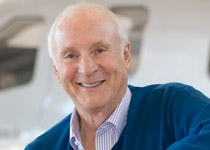Barry Schiff is a retired airline captain who holds 11 type ratings and recently flew the U–2.
You've probably heard some pilot described as having every rating in the book. Consider such a comment as poetic license.
There is no such person. No one is even close. A pilot might have all category and class ratings, but it is virtually impossible for him to have all of the more than 200 type ratings (with more ratings becoming available as new aircraft come on line). Most pilots don't even have one.
A type rating allows a pilot to serve as pilot in command of a large aircraft (one that has a maximum-allowable gross takeoff weight of more than 12,500 pounds) or one that is turbojet powered (irrespective of its gross weight). A separate type rating is required for each such aircraft. For example, for a pilot to be authorized to serve as captain on a Boeing 747-400, Concorde, Ford Tri-Motor, and Grumman Mallard, he would have to have the following ratings emblazoned on his certificate: B-747-4, CONCRD, FO-5, and G-73. (All aircraft for which type ratings are available and their respective designations are listed in FAA Advisory Circular 61-89E.)
Each of these small, cryptic, alphanumeric designations belies the effort required to earn one. Although a written test is not required to obtain a type rating, the oral portion of the practical exam deals with aircraft systems and can be intensive, comprehensive, and lengthy, especially when highly sophisticated aircraft are involved. In such cases, the best way to prepare is to attend a type-specific ground school. The flight test, of course, can be expensive but less so when conducted in a simulator. (An alternative is to become employed by an air carrier or bizjet operator and be paid to obtain a type rating. Note, however, that first officers typically are not type rated.)
Type ratings are available only for civilian aircraft and those ex-military machines that have met FAA certification requirements and have been issued a type certificate. Previously, one could obtain a type rating for a Lockheed P–38 Lightning (L-P38) or a Martin B–26 Marauder (M-B26), but no longer. Instead, the FAA issues a letter of authorization for each such aircraft in which a pilot demonstrates proficiency. Such authorizations often contain limitations, the most common of which prohibits carrying passengers. (Those who previously earned type ratings for strictly military aircraft are allowed to retain them on their current pilot certificates.)
Contrary to popular opinion, one does not need an ATP or commercial pilot certificate to qualify for a type rating. Although it might take more money than common sense, a private pilot can obtain a type rating in an Airbus A340 or a Boeing 747, carry a load of friends, and accept from them their fair share of the operating expenses. "Let's see now. Three hundred and forty-two thousand pounds of fuel divided by 492 passengers comes out to…."
Someone wanting to obtain his first type rating would be better advised to undertake something less expensive and intimidating. My recommendations for a relatively inexpensive "starter" rating would be to train in either a Cessna Citation (CE-500) or a Douglas DC–3 (DC-3). The Citation is easier to fly than a conventional light twin (especially with an engine caged), and the DC–3 is the most fun (especially for those already adept at the fine art of taildragging). A fringe benefit of adding any new category, class, or type rating is that it counts as a flight review.
Although no one has all the ratings, FedEx DC–10 Capt. Robert Briggs apparently has the most. He has every category and class rating (without any limitations) except for "powered lift" aircraft, but this is only because no such aircraft has yet been certified. He also has 75 type ratings, the most recent of which was added to his certificate in March, for a turboprop-powered DC–3 (DC-3TP).
According to a response he received from the FAA Airman Certification Branch in Oklahoma City, the next-closest pilot has 70 type ratings. It makes my 11 seem insignificant.
Briggs acknowledges that it would be impossible for him to obtain every type rating, but one of his goals is to accumulate at least 100 of them. His near-term wish list includes the Convair 240/340/440, the Boeing Vertol BV-44 (the "flying banana"), the Lear 45, and the SAAB-Fairchild 340.
When asked why he has invested as much money in these ratings as it would take to buy a modest Southern California house, he says that he is not unlike avid golfers who "collect" golf courses and dedicated globetrotters who "collect" countries. "I enjoy ‘collecting' airplanes," he says. "Each new type is a challenge and a learning experience. It allows me to sample unique systems and flight characteristics." His favorite ratings include the Boeing Stratocruiser (B-377) and other "smoke-belching, fire-breathing, round-engine recips."
Working toward a new rating is a reminder that all of us are student pilots no matter how many ratings we might already have. When climbing into an unfamiliar aircraft or encountering an unusual situation, we should approach the experience with the same caution, humility, and respect that most of us demonstrated during our original quest for wings. Such an attitude can be of more value than a new rating.
Visit the author's Web site ( www.barryschiff.com).



